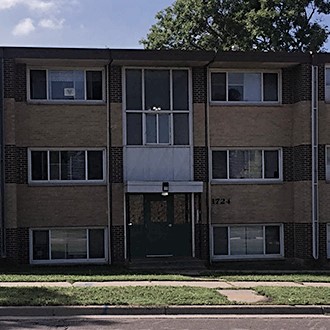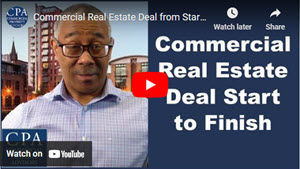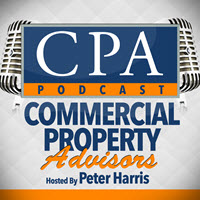
What qualifies as a distressed property? Can you invest in distressed commercial property, renovate, and still turn a profit? In this post, you‘ll discover the answers to these questions, plus strategies to locate, evaluate and capitalize on distressed commercial real estate.
Distressed Commercial Property: An Underperforming Asset
A Distressed commercial property can be defined as an under-performing asset which seriously challenges the owner in one of three ways:
1.Financially
There are several reasons a commercial property could be financially challenging:
- Negative cashflow each month.This financially challenges the owner, causing insufficient cashflow to handle the normal operations. Over time, this leads the property to become distressed.
- The property is „underwater“, meaning they owe more than it‘s worth.
- As a result of a personal issue such as divorce or sickness.
2. Physically
A distressed commercial property could be physically challenging the owner by being obsolete, run down, or having deferred maintenance on the interior or exterior, but no cash to fix it.
3. Legally
The third way a property can be distressed is due to legal challenges. This could be anything from lawsuits, liens, pre-foreclosure, building violations or even deteriorating business partnerships.
Distressed Commercial Property: An Opportunity
“In Every Crisis Lies the Seed of Opportunity.”
All the negatives of distressed properties can be turned into opportunities. The issues listed above can be remedied, and once you fix them, you can turn huge profits. And if you personally are unable to fix one of these issues, you can enlist the help of someone more experienced.
Get the Story
Each deal has a story. It is crucial you get the story, because the more of the story you get, the better you are able to know which strategies to use to purchase the property. You will know which financing strategy will work and what your exit strategy should be. This step is extremely important when purchasing any distressed property so don‘t skip it!
Get Help
Investing in distressed commercial property is not for beginners, so if you are a beginner do not try to do this yourself. Student investors in my Protege Program can invest in distressed property because they have expert help. We help them put these deals together with military like precision. It is critical that you have an experienced, expert guided plan to be successful in your distressed commercial property deals.
4 Strategies for Purchasing Distressed Commercial Property
#1: Finding Distressed Commercial Real Estate
Finding distressed commercial real estate is no different than finding performing commercial real estate. There are several avenues available:
- Online using commercial real estate investing sites
- Broker relationships
- Lender relationships
- Networking
You can use these four methods to find good deals, but GREAT deals are created. Great deals are found by getting the story of a distressed property and by getting expert help on how to proceed with a deal.
#2: When to Purchase Distressed Property
When does it make sense to buy? When the after repair value of the distressed property is greater than the acquisition cost, the repair cost, and the holding cost. The after-repair value (ARV) is the market value when a property is stabilized. So, buy when the ARV is greater than the sum of the acquisition cost, repair cost and holding cost.
Example Deal:
- Acquisition Cost: $1 million dollars
- Repair Cost: $300,000
- Holding cost/Loan cost: $50,000,
- Total Cost: 1.35 Million Dollars
1.35 million divided by 75 = 1.8 million
The ARV needs to be higher than the total cost of the property by 75%. To determine the ARV needed, take the total cost of the property and divide it by 75. In the example deal the ARV is $1.8 million so it‘s a good deal. The 75% target is important as a goal number, but it is also important for refinancing reasons. If the ARV is $1.8 million the lenders will lend you 75% of your after-repair value as a new, permanent loan. Since you typically buy a distressed property with a hard money or a bridge loan, after it is renovated you will need to refinance into more permanent financing.
So if the ARV is $1.8 million and the bank will loan 75% of that, then that equals $1.35 million which was your total cost of the property. This means the loan will cover your original hard money loan, plus reimburse you for your repairs and holding costs.
#3: Financing Distressed Commercial Property
A. Conventional Financing: Banks or Traditional Loan Office
With conventional financing, the lender will look at four things to underwrite a deal:
- They will qualify you.
- Qualify the property.
- Qualify the area of the property.
- The financials of the property
Usually the financials of a distressed commercial property won’t qualify for a traditional loan, which makes a hard money loan another option. I have a video on how hard money loans work and give as an example one of our students who used a hard money loan to purchase his first commercial property. However, the down side is hard money loans are expensive and do not leverage very high. The interest rates can be between 12 to 15%, and it can cost 4% to 6% upfront origination points as well just to use the money.
Whereas a bridge loan is a gentler form of hard money. It’s called a bridge loan because it is a temporary loan, allowing you to buy the property, fix it up, and then it bridges you towards permanent financing. The interest rates are 7 to 8% and will only cost you 1-2% upfront origination points. Out of the traditional loans, this is the best option for purchasing distressed property.
B. Creative Financing: Unconventional Loans
Since most distressed properties have financial and physical issues that cause traditional funding to be difficult or impossible, I use creative financing techniques when purchasing them. Most distressed properties have financial and physical issues that cause traditional funding to be difficult or impossible. With creative financing you can create your own terms and be as creative as you want, if the seller agrees to the terms.
Seller Financing: With this technique the seller becomes the bank. The seller can give you your first or second loan on the property in order to close the deal. I have a video called Creative Financing with Commercial Real Estate which explains how seller financing works in greater detail.
Master Lease Agreement: A master lease agreement involves putting a mortgage over the seller’s mortgage. No banks, credit checks, or appraisals are required, and you can be as creative as you want when using a master lease agreement. I have an extensive video on this strategy as well you can watch to learn more.
Joint Venture with the Seller: If the seller had code violations with the city but no money to repair them, a strategy you could use is to contribute money to fix the violations with part ownership of the property.
#4: Exit Strategies for Distressed Commercial Properties
Having an exit strategy before buying any property is of utmost importance. In fact, when you are making an offer, you should have several exit strategies already planned out. Here are 3 possible exit strategies:
- Purchase the property, renovate it, and then sell it. You can take the earnings as payment or invest it in a larger property and do a 1031 exchange.
- Buy the property, fix it up, and then hold long term for cash flow. You will need a long term loan with a low interest rate. This strategy is often chosen by investors as a way to fund their retirement. They replace their 401K or self-directed IRA with this exit strategy to establish long-term passive income.
- You purchase the property, fix it up, and cash out refinance. A cash out refinance is where you pull the cash out that you put in and then hold long term. This is called the syndicator strategy because a syndicator pools other people’s money together to purchase real estate. Their strategy is to buy it, fix it up, pull the down payment out over time and then hold it long term for cash flow.
In my opinion, the cashout refinance is the best strategy for wealth building and portfolio growth. I find it to be the most rewarding and fun strategy as well. You buy a great property, at a good price and eventually get to the point where you can pull out all the cash and hold on for long-term cashflow.
Example Deal #1:
Property: 100 unit apartment building
Occupancy Rate: 60% occupancy rate or in other terms 40% vacancy rate. (Lenders consider any property with a 20% or more vacancy rate to be distressed)
Financial Challenges: Economic occupancy is 50%. This means that even though the property has 60 tenants inside, only 50 of those tenants are paying their rent. The property was also close to foreclosure.
Creative Financing Technique: The deal was financed with a hard money loan with a seller-carry second mortgage. We chose to use hard money because the occupancy rate was an issue for traditional loan offices. A seller-carry second mortgage was used because the buyer had limited funds and it was the only way to get the return on investment required to make the deal happen.
Outcome: In four years there is a $2.5 million dollar projected profit. It turned out to be an amazing deal and everything is working out great.
Example Deal #2:
Property: 6300 square foot building located in a great area.
Physical Challenges: In very poor condition because the owner spent a lot of time out of the country and had become very disinterested in the property.
Financial Challenges: Since the owner is an absentee landlord, most of the tenants have stopped paying their rent, even though it is well below market.
Creative Financing Technique: The property was purchased at $57 per a square foot using 100% investor money. Comparable sales of similar buildings in the area sold for $98 a square foot.
Exit Strategy: To do a 1031 tax deferred exchange upon selling the property. The process can take up to two years, but once it sells, you can buy a larger property with the profit, thus deferring the capital gains tax.
The Right Investor Mindset
To purchase a distressed commercial property, you must have the right mindset. The average investor will know the signals of distress but is unable to do anything about it. This is because they have a customer mindset, which causes them to focus on what something will cost rather than the potential benefit.
Whereas the opportune investor has an entrepreneur mindset and focuses on how to get a deal done. Their focus is on how to get the deal done and how to find the help to make it successful. I have a helpful post on this subject called, “The Right Mindset for Investing in Commercial Real Estate”



